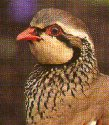 The Red-legged Partridge is very similar to the Chukar. Although common in captivity, it is not bred on the large, commerical scale as it’s close cousin. There are four subspecies in the wild. The French Red-leg (A. r. rufa) of France and Italy, is the subspecies most often seen in captivity (it also the bird pictured to the right). The Spanish Red-leg (A. r. hispanica), is found in northern and western Spain is also kept, but not as common as the French subspecies. There is another subspecies that is resident in eastern and southern Spain, the Southern Spanish Red-leg (A. r. intercedens); the last subspecies is native to Corsica, the Corsican Red-leg (A. r. corsa). There is only slight differences in the subspecies, and the Corsican is almost indistinguishable from the French. This species has been introduced into many places worldwide, including the Canary Islands, the Azores, England and some parts of North America.
The Red-legged Partridge is very similar to the Chukar. Although common in captivity, it is not bred on the large, commerical scale as it’s close cousin. There are four subspecies in the wild. The French Red-leg (A. r. rufa) of France and Italy, is the subspecies most often seen in captivity (it also the bird pictured to the right). The Spanish Red-leg (A. r. hispanica), is found in northern and western Spain is also kept, but not as common as the French subspecies. There is another subspecies that is resident in eastern and southern Spain, the Southern Spanish Red-leg (A. r. intercedens); the last subspecies is native to Corsica, the Corsican Red-leg (A. r. corsa). There is only slight differences in the subspecies, and the Corsican is almost indistinguishable from the French. This species has been introduced into many places worldwide, including the Canary Islands, the Azores, England and some parts of North America.
The colors of both sexes are similar to other members of the genus, but has a white forehead and a broken black line on the neck and throat which distinguishes them from the other species. The flanks are also more barred with brown and buff, mixed with white. The males have small spurs and are slightly larger than the females.
Breeding
The breeding season begins in late April and early May. Like the chukar, Red-legs are unlikely to set and hatch their own eggs. Incubation lasts about 23 days and the young should be treated in the same matter as the Chukar. They do not lay the large number of eggs as a Chukar hen, clutches are only about 10 to 12 per bird.
General Comments
Red-legged Partridge do best when raised on wire. They are prone to a number diseases transmitted by wet soil, including Blackhead which is very common in partridge. If the birds are infected with Blackhead, you can use the drug Emtryl as treatment.
This species is hardy and easy to keep in captivity. Some feel that they are a better game bird than the chukar, since they prefer a more grassland like habitat. Some game bird preserves have crossed them with Chukars for release.


